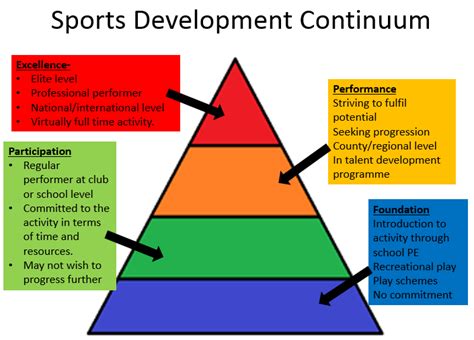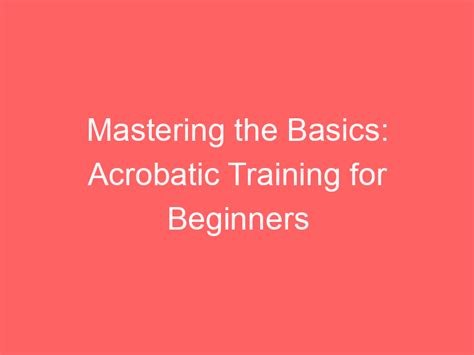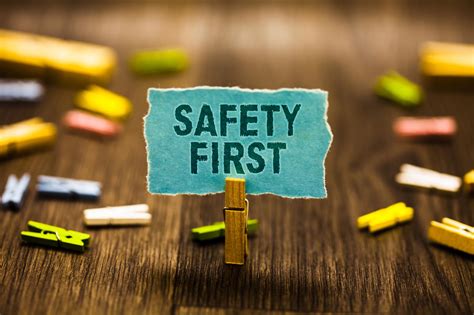Unleashing the potential within, exploring the extraordinary, and seizing the untamed thrill of defying gravity - all combine to form the mesmerizing realm of acrobatics. It is an art that transcends the boundaries of physical possibility and dares us to embrace the extraordinary. Stepping into the spotlight, acrobats are bold individuals who possess a unique blend of strength, agility, and creativity, enabling them to astound audiences with their electrifying performances.
Basked in a symphony of gasps and applause, the world of acrobatics is a captivating fusion of grace, artistry, and courage. It is in the intricately woven tales told through leaps, twirls, and spins that the true essence of human potential is unraveled. The acrobat, much like a poet, uses their body as a canvas, fearlessly pushing the limits of what is considered possible, and painting a breathtaking tableau of daring maneuvers.
Within the realm of acrobatics, the journey begins long before the first step is taken on stage. It unfurls amidst countless hours of rigorous training, where strength is nurtured and flexibility is honed. The aspiring acrobat tirelessly refines their technique, dedicating themselves to the mastery of daring acts that push the boundaries of the human physique. Through perseverance and passion, they embrace the mesmerizing fusion of power and grace, transcending the ordinary and embarking on a quest for greatness.
Developing Physical Strength and Flexibility: A Pathway to Achieving Success as an Aerial Performer

Exploring the world of acrobatics requires individuals to possess not only incredible artistry and grace but also a remarkable level of physical strength and flexibility. It is through the dedicated practice of various exercises and training techniques that aspiring acrobats can build the foundation necessary to soar to new heights in their chosen discipline.
Emphasizing the importance of building physical strength, acrobats engage in a range of exercises that target different muscle groups in their bodies. These exercises may include weightlifting, bodyweight exercises, and resistance training among others. By challenging their muscles in strategic ways, acrobats are able to enhance their power and endurance, enabling them to execute stunning aerial maneuvers with ease and precision.
- To develop upper body strength, acrobats often incorporate exercises such as pull-ups, push-ups, and dips into their training regimen. These exercises target the muscles in the arms, shoulders, and chest, allowing for the development of the strength required to perform gravity-defying stunts.
- Building core strength is also vital for acrobats as it provides stability and control during aerial performances. Pilates, planks, and various abdominal exercises are commonly practiced to strengthen the muscles in the abdomen, lower back, and hips.
- In addition to strength, flexibility plays a crucial role in an acrobat's ability to perform extraordinary feats. Incorporating regular stretching routines into training sessions helps improve joint mobility and muscle flexibility. Yoga, for instance, is a popular discipline that acrobats often embrace to enhance their range of motion and achieve greater fluidity in their movements.
By dedicating time and effort to building physical strength and flexibility, aspiring acrobats can lay a strong foundation for their journey towards realizing their dreams. Combining rigorous exercise routines with discipline and determination, these individuals pave their way towards reaching new heights as they defy gravity and astound audiences with their breathtaking performances.
Finding the Perfect Training Program: Paving the Path to Achieving Aerial Mastery
Embarking on a journey towards becoming an expert performer in the exhilarating world of acrobatics requires careful consideration and research when it comes to selecting the right training program. In this section, we explore the key factors to look out for, as well as the various aspects that contribute to creating a successful and fulfilling training experience.
When searching for the ideal training program, it is essential to consider the curriculum offered, ensuring it aligns with your specific goals and aspirations. Look for programs that provide a comprehensive range of training techniques and disciplines, catering to both foundational skills and advanced maneuvers. A well-designed program should incorporate elements such as strength training, flexibility exercises, aerial conditioning, and performance skills development.
Another crucial aspect to consider is the expertise and qualifications of the instructors. Seek programs that are led by experienced professionals who possess extensive knowledge and a deep understanding of the art of acrobatics. These instructors should be able to provide personalized guidance and feedback, fostering a supportive environment that encourages growth and continuous improvement.
Additionally, it is important to evaluate the training facility itself. Look for a space that is equipped with state-of-the-art equipment, ensuring safety and optimal training conditions. Consider the size of the facility, as it should provide ample space for practicing various maneuvers and allowing for a comfortable learning environment.
Cost and location are also factors that play a significant role in choosing the right training program. Assess your budget and identify programs that offer value for money while considering the cost of tuition, any additional fees, and potential accommodation expenses if the program is located away from your home. Furthermore, it is crucial to assess the program's location in relation to your living situation and other commitments, as finding a program that fits into your schedule without causing excessive disruption is essential.
| Bullet Points to Consider: |
|---|
| - Curriculum alignment with personal goals and aspirations |
| - Comprehensive range of training techniques and disciplines |
| - Experienced and qualified instructors |
| - Well-equipped training facility |
| - Consideration of cost and location |
By carefully evaluating the curriculum, instructors, training facility, and logistical factors such as cost and location, you can make an informed decision in finding the ideal training program that will lead you down the path towards aerial mastery and unlocking the boundless potential within you.
Mastering Fundamentals of Acrobatic Techniques

Embarking on a journey to excel in the captivating world of acrobatics requires a firm grasp of the essential techniques that form its foundation. In this section, we will explore the fundamental principles and skills necessary to become a proficient acrobat, unlocking new possibilities for expression, strength, and grace.
Building Strength and Flexibility: It is essential for aspiring acrobats to develop superior physical strength and flexibility. By consistently engaging in targeted exercises that target core muscles, upper body strength, and lower body stability, acrobats can enhance their control and execution of gravity-defying maneuvers. Emphasizing the cultivation of flexibility within muscles and joints ensures fluid movements and helps prevent injuries during demanding acrobatic performances.
Honing Balance and Coordination: Achieving a harmonious balance between mind and body is key to mastering acrobatic techniques. By training balance exercises that challenge equilibrium and concentration, acrobats can progressively improve their stability and control while executing intricate movements. Coordinating movements with precision is another vital aspect to master, allowing acrobats to seamlessly flow from one gravity-defying maneuver to another, captivating audiences in the process.
Perfecting Body Alignment: Akin to the structure of a building, proper body alignment forms the cornerstone of a successful acrobat's performance. Every movement, from a simple pose to a complex aerial trick, requires meticulous attention to body alignment. Acrobats must train to align their spine, limbs, and joints in such a way that maximizes efficiency, minimizes strain on the body, and translates into polished movements that showcase elegance and control.
Gaining Spatial Awareness: Developing a keen sense of spatial awareness is essential to navigate through the dynamic world of acrobatics confidently. Acrobats need to train their perception of space, practicing techniques that enable them to gauge distances accurately and make split-second decisions while executing intricate maneuvers. By mastering spatial awareness, acrobats can push the boundaries of their performance, infusing it with creativity and innovation.
Cultivating Mental Resilience: Acrobatics demands mental resilience, as acrobats must confront fears, embrace challenges, and persist in the face of setbacks. By adopting a mindset of determination, acrobats can overcome obstacles and push their boundaries, fostering continuous growth and improvement. Cultivating mental resilience also involves developing trust in oneself and fellow performers, enabling seamless synchronization, and elevating acrobatic performances to new heights.
By mastering the fundamental techniques outlined in this section, aspiring acrobats lay a strong foundation for their exciting journey towards becoming accomplished performers. With dedication, practice, and a love for pushing boundaries, the sky's the limit for those daring enough to embark on this remarkable artistic pursuit.
Pushing Boundaries: Advancing Acrobatic Abilities
In the exhilarating world of acrobatics, there exists a realm where performers, driven by their relentless passion for pushing the boundaries, delve into the realm of advanced acrobatic skills. This astounding realm transcends conventional limits and propels acrobats to unimaginable heights of performance, finesse, and athleticism.
Within this mesmerizing realm, acrobats go beyond the familiar, venturing into uncharted territories of physicality and dexterity. They embrace the challenge of mastering complex maneuvers, incorporating fluidity, precision, and breathtaking artistry into their craft. These extraordinary individuals embark on a constant quest to refine their skills, expanding their repertoire and defying the constraints of what is deemed possible.
- Elevated Aerial Techniques: Acrobats equip themselves with a wealth of technical expertise to execute awe-inspiring aerial maneuvers. From mesmerizing flips and twists to heart-stopping drops and spins, they conquer gravitational forces and create a mesmerizing symphony of grace and strength in the air.
- Gravity-Defying Balancing Acts: Displaying an extraordinary sense of poise and control, acrobats take on gravity as they push the limits of balance. Engaging every muscle fiber, they amaze audiences with gravity-defying handstands, headstands, and intricate contortions that defy the laws of physics.
- Intricate Partner Acrobatics: Collaborative in their pursuit of excellence, acrobats form dynamic partnerships to explore the art of partnering acrobatics. With seamless synchronization, they perform awe-inspiring balancing acts, lifts, and tosses, embodying trust, communication, and unparalleled connectedness.
- Unconventional Prop Manipulation: Going beyond traditional forms of acrobatics, performers experiment with a myriad of objects and props, incorporating them into their acts. From daring feats with aerial silks to astonishing juggling displays, their creativity knows no bounds as they reinvent the possibilities within the acrobatic realm.
- Incorporating Artistic Expression: Acrobats transcend the mere execution of physical feats, infusing their performances with artistic expression. Every movement becomes a canvas for creativity, replete with storytelling, emotional depth, and captivating choreography that captivates the audience's imagination.
The realm of advanced acrobatic skills is a testament to human determination, showcasing the infinite potential of the human body and spirit. It is a world where the relentless pursuit of excellence fosters innovation, inspiration, and unrivaled beauty. As acrobats continue to evolve their craft, they inspire us all to defy limitations and embrace the extraordinary.
Taking Precautions: Ensuring Safety & Preventing Injuries

When pursuing the thrilling and physically demanding career of an acrobat, one must always prioritize safety and injury prevention. While pushing the boundaries of human potential and achieving breathtaking feats requires courage and determination, it is essential to establish a foundation of precautionary measures to minimize the risk of accidents and injuries.
With the acrobat's incredible ability to achieve gravity-defying stunts, it is crucial to understand the potential risks involved and take proactive steps to mitigate them. By implementing strict safety protocols and investing in high-quality equipment, acrobats can maximize their performance while minimizing the chances of injury.
One of the key components in injury prevention is comprehensive physical conditioning. Regular strength and flexibility training enable acrobats to maintain optimal physical fitness, thereby enhancing their ability to perform complex maneuvers with precision and control. Additionally, incorporating warm-up and cool-down routines into training sessions helps reduce the risk of muscle strains and tears.
Proper technique and proficiency in executing acrobatic movements also play a vital role in preventing injuries. Acrobats must undergo rigorous training to develop proper form and body alignment, which not only enhances their performance but also diminishes the likelihood of accidents during practice or on stage.
Furthermore, a well-maintained and safe training environment is crucial for an acrobat's injury prevention plan. Regular inspections of equipment like safety mats, nets, and rigging, are necessary to ensure their durability and reliability. Adequate supervision and support from trained professionals also play a significant role in safeguarding acrobats during training and performances.
Ultimately, prioritizing safety and injury prevention is imperative for acrobats to thrive in their daring and exhilarating profession. By implementing a comprehensive plan that includes proper training, equipment maintenance, and a commitment to keeping physical well-being at the forefront, acrobats can fearlessly embark on their journey to reaching new heights without compromising their safety.
The Importance of Mental Focus and Self-Discipline
Within the realm of acrobatics, achieving greatness goes beyond the physical aspects of the art. It requires a profound level of mental focus and unwavering self-discipline. This section delves into the crucial role that these two attributes play in the pursuit of acrobatic excellence, highlighting their significance in overcoming obstacles, honing skills, and pushing boundaries.
1. Mental Focus: One of the key factors that sets successful acrobats apart from the rest is their ability to maintain an exceptional level of mental focus. The art of acrobatics demands intense concentration and attention to detail. It involves executing precise movements, anticipating the actions of fellow performers, and seamlessly synchronizing each action. Mental focus enables performers to stay completely present in the moment, eliminating distractions and allowing them to perform at their peak. |
2. Self-Discipline: Acrobatics requires unparalleled self-discipline. It involves rigorous training regimens, countless hours of practice, and unwavering commitment. Self-discipline pushes acrobats to persevere through physical and mental exhaustion. It enables them to follow strict routines, maintain a healthy lifestyle, and make sacrifices for their craft. Without self-discipline, acrobats would not possess the resilience needed to overcome challenges and reach new heights of achievement. |
3. The Symbiotic Relationship: Mental focus and self-discipline work hand in hand to drive an acrobat towards greatness. While mental focus sharpens the mind and keeps the performer attuned to each movement, self-discipline provides the structure and dedication necessary to continuously improve. The symbiotic relationship between these two attributes is what allows acrobats to conquer fears, refine their techniques, and continuously surpass their previous limits. |
4. Rising Above Challenges: Acrobats encounter countless challenges throughout their journey. Mental focus and self-discipline are the pillars that give them the fortitude to rise above these obstacles. Whether it's conquering fear while attempting daring stunts or pushing through physical fatigue during demanding training sessions, these attributes allow acrobats to tap into their inner strength and push their boundaries further than ever before. |
5. Inspiring Others: Acrobats who possess exceptional mental focus and self-discipline become more than just performers; they become inspirations to others. Their ability to elevate themselves to extraordinary heights through sheer determination and a strong mindset motivates and encourages aspiring acrobats to believe in their own potential. By exemplifying the role of mental focus and self-discipline, these acrobats pave the way for a new generation of aspiring artists. |
Understanding the critical role of mental focus and self-discipline in the world of acrobatics is essential for those embarking on this extraordinary journey. It is these attributes that separate the exceptional acrobats from the ordinary and enable them to transform seemingly impossible dreams into awe-inspiring reality.
Pursuing a Career as an Aerial Artist: Opportunities and Challenges

Embarking on a journey to achieve greatness in the captivating world of aerial arts presents both exciting possibilities and inevitable obstacles. As aspiring performers set their sights on a career as an aerial artist, they are met with a range of opportunities and challenges that require dedication, resilience, and a relentless pursuit of perfection.
| Opportunities | Challenges |
|---|---|
| 1. Expanding Artistic Horizons | 1. Physical Demands and Risks |
| 2. Collaboration and Creativity | 2. Competitive Industry |
| 3. Performance Versatility | 3. Balancing Passion and Financial Stability |
| 4. Travel and Cultural Exchange | 4. Mental and Emotional Resilience |
Opportunities:
Expanding artistic horizons: Aerial artists have the chance to push the boundaries of their creative expression through innovative performances, utilizing various apparatuses and exploring unique choreographic concepts.
Collaboration and creativity: Engaging with fellow artists, choreographers, and directors fosters a stimulating environment that encourages collaboration and allows for the creation of breathtaking and memorable performances.
Performance versatility: The versatility of aerial arts provides artists with the opportunity to explore different styles and techniques, ranging from graceful and lyrical movements to dynamic and powerful displays.
Travel and cultural exchange: Aerial artists often have the privilege of performing in different locations around the world, immersing themselves in diverse cultures and experiencing the enriching impact of global artistic communities.
Challenges:
Physical demands and risks: A career as an aerial artist requires rigorous training and conditioning, as well as the ability to navigate the physical demands and potential risks associated with performing at heights.
Competitive industry: The pursuit of a successful career as an aerial artist involves competing with a vast pool of talented individuals, necessitating continuous growth, constant self-improvement, and the ability to stand out in a sea of remarkable performers.
Balancing passion and financial stability: While pursuing their passion for aerial arts, artists often face the challenge of striking a balance between following their dreams and ensuring financial stability. Finding ways to generate income through performances, teaching, or other related avenues is essential for long-term sustainability.
Mental and emotional resilience: The demanding nature of the industry, including the pressure to perform flawlessly and the potential for rejection, requires aerial artists to possess strong mental fortitude and emotional resilience to overcome setbacks and continue on their path to success.
FAQ
What does it take to become an acrobat?
Becoming an acrobat requires a great deal of physical strength, flexibility, and coordination. It also requires years of training in specific acrobatic skills such as tumbling, aerial tricks, and balancing. Mental resilience and a strong work ethic are also essential.
Is it dangerous to be an acrobat?
Yes, being an acrobat can be dangerous. Acrobats perform daring stunts and acrobatic maneuvers that involve heights and potential risks. However, with proper training, safety precautions, and technique, the risk can be minimized. Acrobats also undergo regular physical conditioning to enhance body awareness and reduce the chance of injury.
Can anyone become an acrobat?
In theory, anyone can become an acrobat. However, it requires a certain level of physical fitness, agility, and determination to succeed. In addition, starting at a young age and having a background in gymnastics or dance can be advantageous, as it helps develop the necessary skills and body control needed for acrobatics.
How long does it take to become a professional acrobat?
The time it takes to become a professional acrobat varies for each individual. Generally, it takes several years of training and practice to reach a professional level. This includes mastering fundamental acrobatic techniques, building strength and flexibility, and gaining performance experience. It's not uncommon for acrobats to spend at least 5-10 years honing their skills before becoming professionals.
What are the career opportunities for acrobats?
Acrobats have various career opportunities. They can join professional circus troupes, perform in stage shows, work in theme parks, or be part of acrobatic entertainment groups. Some acrobats also become instructors and coaches, passing on their knowledge and skills to future generations. Additionally, acrobats may find opportunities in the film and television industry, performing in stunt sequences or as part of a choreographed routine.



